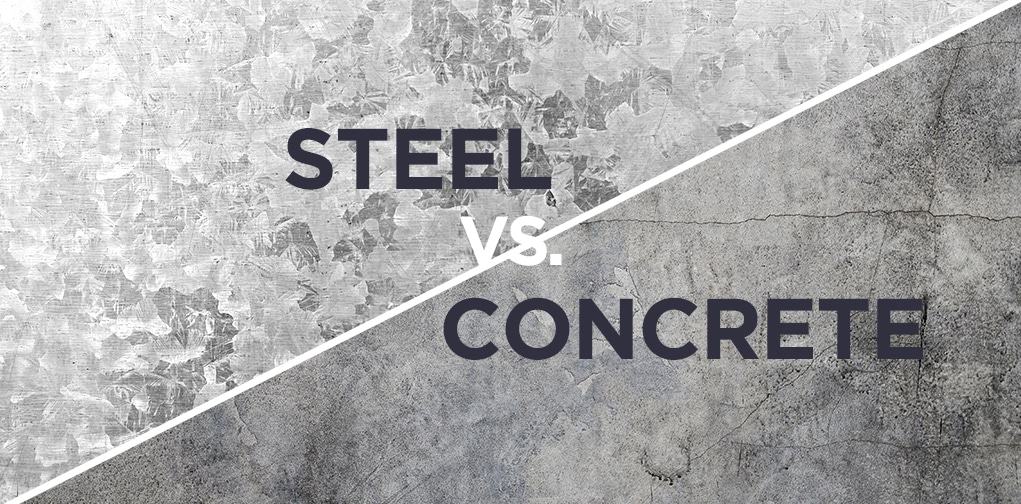When building low-rise buildings, there is one common question asked: is steel stronger than concrete?
COMPARE PRICES & SAVE UP TO 33%
Both materials are strong, and construction may depend on budget rather than strength because both materials are acceptable for most buildings.
Strength of Steel Vs Concrete
Steel is known for being one of the leading materials in industrial building because of its strength. When you choose steel, you’re choosing a material that is:
- Strong
- Ductile
- Stiff
- Tough
Concrete is made of composites, and the material has a very high compression strength. While a great material to use, concrete lacks tensile strength.
Concrete often uses steel rebar to allow the material to offer higher levels of:
- Ductility
- Elasticity
- Tensile capacity
Steel offers the highest strength-to-weight ratio for building materials, and that’s why builders opt for steel over concrete when building large office buildings or multifamily developments. Higher ceilings and greater overall construction ability are possible with steel.
When trying to accomplish long spans without the need for columns, as is a popular choice in many metal buildings, steel is chosen. The material is able to provide the strength needed for vast, open spaces without the need for columns to help with weight support.
Steel is generally a flexible material that is able to meet a lot of design requirements that other materials are unable to provide.
Fire Resistance Properties
When considering fire resistance, steel and concrete are on par with each other. Steel is not combustible, but there are structural issues in extreme heats. If there’s a fire made with an accelerant, it’s possible that steel’s strength will be compromised.
Steel is meant to be covered in another fire-resistant material to meet IBC requirements.
Concrete is meant to be fire resistant and is able to meet IBC requirements without the need for further material use to make it fire resistant. The biggest concern is that some of the materials used in construction are not fire resistant, so these additional components will need to have fire resistant properties for the building to be structurally safe in a fire.
Steel, on the other hand, usually uses steel beams and columns which are highly fire resistant and only become an issue in extreme temperatures.
Corrosion of Steel Vs Concrete
Corrosion is a major concern when considering one construction material over another. Climate will play a big role in the decision as well because homes near the ocean have to worry about the corrosive properties of salt.
Steel may corrode when it comes in contact with water, but the corrosion would take a significant amount of time to occur.
Water resistant seals are often put on the steel to help provide resistance to potential corrosion.
Concrete requires proper care and construction methods to help keep the concrete strong. Chloride ions are the most common cause of concrete corroding and can also impact the steel in reinforced concrete.
The Eco Considerations For Using Steel
Steel is often the go-to option for construction materials especially when a large-scale building is constructed. The material is one of the world’s most recycled metals, so it is a sustainable material and one of the “greenest” in the world.
Steel’s cost is often negated thanks to the material’s low maintenance concept that requires virtually no long-term costs.
Concrete will require continual maintenance and repair making ownership of buildings cost higher in the long-term.
There’s also the consideration that concrete will need to be cured and construction time is longer for concrete than it is for other materials. Steel can be prefabricated, brought to a building a location and allows for rapid construction.
Costs for constructing steel buildings and the complexities are less when compared to concrete.
Concrete is known for being sourced locally but creating the material does have a significant environmental impact. Even when recycled, the material can no longer be used for constructing buildings. The lack of recycling capacity should be a consideration in large-scale projects.
Steel is 85% recycled and can be reused for multiple applications.
What about Steel Reinforced Concrete?
Steel and concrete both have their benefits and drawbacks. Builders that want to leverage the benefits of both materials will often opt for steel reinforced concrete. There’s no reason to settle when you can choose a hybrid version of both materials.
Steel reinforced concrete offers:
- Greater strength and compression
- Versatility in shape and framework for architectural freedom
- Fire resistance
- Ductility to prevent damage
- Greater seismic resistance
The choice of material is up to the builder and owner, but steel reinforced concrete provides the benefits of combining both materials into one extra-durable option.
It’s important to note that when concrete reinforced steel is used that corrosion will be a major concern. Once the outer layer of concrete corrodes, the steel will be exposed and can corrode, too.
Reinforced concrete must be properly maintained to enjoy the strength and quality benefits of the material.

